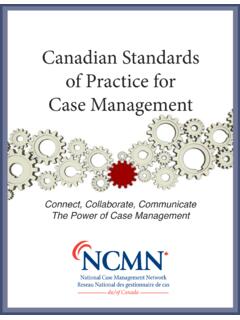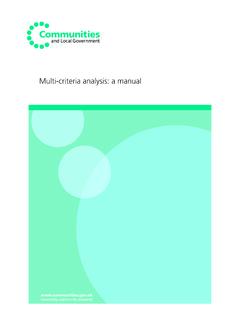Transcription of Models of delivery for stop smoking services: options and ...
1 Models of delivery for stop smoking services options and evidence About Public Health England Public Health England exists to protect and improve the nation s health and wellbeing, and reduce health inequalities. We do this through world-class science, knowledge and intelligence, advocacy, partnerships and the delivery of specialist public health services. We are an executive agency of the Department of Health, and are a distinct delivery organisation with operational autonomy to advise and support government, local authorities and the NHS in a professionally independent manner. Public Health England Wellington House 133-155 Waterloo Road London SE1 8UG Tel: 020 7654 8000 Twitter: @PHE_uk Facebook: For queries relating to this document, please contact: Crown copyright 2017 You may re-use this information (excluding logos) free of charge in any format or medium, under the terms of the Open Government Licence To view this licence, visit OGL or email Where we have identified any third party copyright information you will need to obtain permission from the copyright holders concerned.
2 Published September 2017 PHE publications PHE supports the UN gateway number: 2017342 Sustainable Development Goals 2 Models of delivery for stop smoking services Contents About Public Health England 2 Foreword 4 Stop smoking services and evidence-based interventions 5 Models of service delivery 9 Additional good practice for commissioning 15 Key Guidance 16 References 17 List of abbreviations Carbon Monoxide CO CleaR tobacco control self-assessment tool CLeaR Joint Strategic Needs Assessment JSNA National Centre for smoking Cessation and Training NCSCT National Institute for Health and Care Excellence NICE Nicotine Replacement Therapy NRT Acknowledgement: This document has been produced with the support of Professor Robert West, Professor of Health Psychology, University College Models of delivery for stop smoking services Foreword Tobacco control in England is changing fast.
3 smoking rates are falling faster than at any time in the last decade yet the most deprived families, people with mental health problems and many pregnant women in deprived communities are being left behind. New but uncertain approaches are emerging and while supporting patients who smoke to quit is key to NHS sustainability, many local authorities are finding universal evidence-based services hard to sustain. In preparing this tool we are responding to reports of local need and we are grateful to colleagues in local authorities who have provided feedback and helped us make important improvements. This is just one part of a family of tools that Public Health England offers to help local decision makers in relation to tobacco control: Local Tobacco Control Profiles offer an up-to-date picture of local prevalence and permit swift and reliable comparisons with other similar localities; JSNA support packs are produced annually for every local authority combining local data with commissioning prompts; and CLeaR self assessments offer a powerful diagnostic tool for system-wide improvement.
4 Which tool fits best will depend on where a locality is on its journey to becoming smokefree. Providing support for smokers to quit is highly cost effectivei and the evidence is clear that smokers who receive a combination of pharmacotherapy and skilled behavioural support are up to four times as likely to quit successfullyii. It is clear that to reduce inequalities and improve public health, local systems need to identify their priority populations and provide them with this effective support to quit. These groups will be determined locally, but may include pregnant women, people with mental health problems, routine and manual workers and those with long term conditions. Aim of this paper This briefing is intended to support directors of public health and local healthcare commissioners in rapidly appraising the evidence, to enable informed decisions around the provision of local stop smoking support.
5 In it we: describe interventions to support smokers to stop and evidence of effectiveness (service components) set out the different Models for delivering these interventions currently being considered by local authorities (service Models ) Martin Dockrell, Tobacco Control Programme Lead Public Health England 4 Models of delivery for stop smoking services 1. Stop smoking services and evidence-based interventions Stop smoking services were rolled out nationally in 2000 and since that time have supported an estimated 1 million smokers to quit for good, typically heavy smokers at greatest risk from smoking -related diseases. These services have been built around the principle of a universal offer of support available for all smokers, with a combination of behavioural support and pharmacotherapy.
6 In 2017, whilst evidence for this model remains strongest, it is recognised that due to changes in commissioning and budgetary constraints local areas are now in some cases considering alternative modes of delivering stop smoking support. A broad base of peer-reviewed evidence and official guidance is available on stop smoking interventions and how services to support smokers should be provided. This includes information from the Cochrane Collaborationiii, NICE (PH10iv & QS43v), and the NCSCT Service and delivery Guidancevi, which rates different interventions according to evidence of effectiveness. Table 1 contains details of interventions that may be included in the package of support offered by a local stop smoking service. These are ranked in order, starting with interventions that have the strongest evidence base for effectiveness.
7 A short summary of each component is provided, along with an indication of the likely effect size and a brief recommendation related to commissioning. 5 Models of delivery for stop smoking services Table 1: Stop smoking interventions ranked for evidence of effectiveness and effect size Rank Component1 Summary Evidence of effectivenessvii When done properly, boosts quit rates by ..4 Commissioning recommendation 1. Face to-face group support with pharmacotherapy Weekly group sessions facilitated by one or more specialist stop smoking practitioners2 with a number of smokers at a specified time and place, lasting approx. 1 hour for between 6 and 12 weeks. All smokers have access to their choice of pharmacotherapy and smoking status is verified by Carbon Monoxide (CO) monitoring at each session.
8 A 300% This format has a very strong evidence base and will produce high success rates. It may be more applicable in an area or setting with a fairly large pool of smokers (a minimum of eight members is recommended to start a closed group). It is important that practitioners receive specialist training and continued supervision. 2. Face-to-face individual support with pharmaco-therapy Weekly sessions for an individual smoker with a specialist stop smoking practitioner, at a specified time and place, sessions averaging approx. 30 45 minutes over a 6 12 week period. All smokers have access to their choice of pharmacotherapy and smoking status is verified by Carbon Monoxide (CO) monitoring at each session. A 200-300% The majority of stop smoking interventions currently take place through one-to-one sessionsviii.
9 It is important that practitioners receive specialist training and continued supervision. 3. Supported use of pharmacotherapy This option involves providing smokers with stop smoking medication(s) (varenicline, NRT, bupropion) of their choice and giving appropriate information and support to use it in a way that will maximise effectiveness. It just needs one appointment to get started and one follow-up to check progress. A3 50-100% The easiest way to commission this is through GP prescriptions, but pharmacies may also be an option. It is essential to make varenicline and dual form NRT (eg transdermal patch plus a faster acting form) available as these offer the best chances of success. 4. Telephone support Multiple sessions of proactive telephone support provided by a trained advisor for 6 12 weeksix.
10 Sessions average 15 30 minutes and work best with multiple sessions in the first A 50-100% The boost in quitting rates depends on following optimal treatment protocols, with proactive telephone calls made by the specialist advisor to the individual 6 Models of delivery for stop smoking services week. Important to have a system for smokers to access stop smoking pharmacotherapy. While evidence of effectiveness is strong in the US, it is weaker for programmes tried in the UK. who has sugned up for this support. If a way can be found for smokers easily to access medication, the boost should be greater. 5. Text message support Although evidence is a bit more limited on text messaging, it is clear that it can improve quit success rates compared with nothing. Because we have less evidence it is important to use a programme that has been tested directly.











